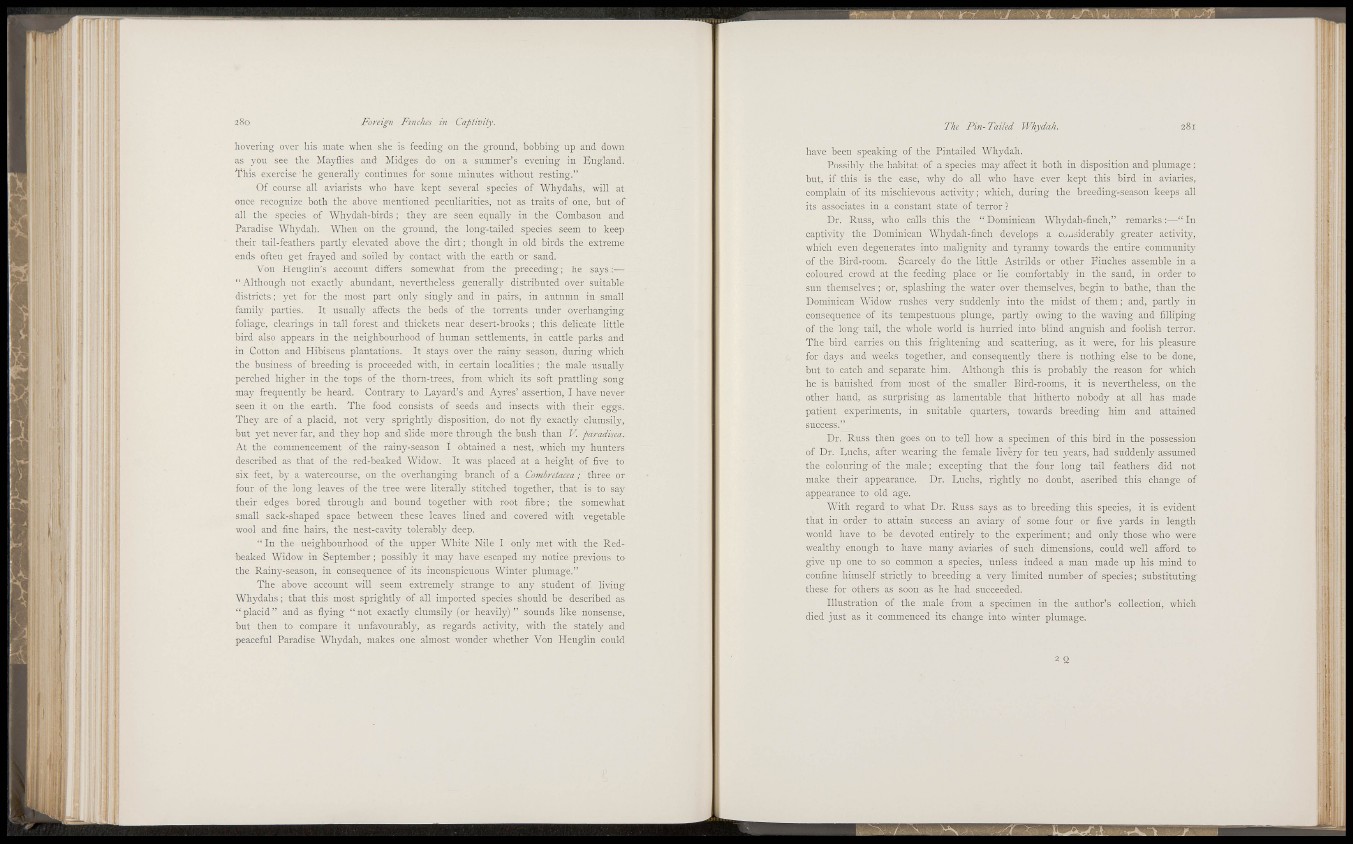
¿'¡.Sgy"
; i '
• I
i I
I
m I
i I . •;
l i ;
i -t
• • i
1 r
2 8 0 Foreign Finches in Captivity.
hovering o^•el• his mate when she is feeding on the ground, bobbing up and down
as you see the Ma3.-flies aud Midges do on a summer's evening in England.
This exercise he general!}' continues for some minutes without resting."
Of course all aviarists who have kept several species of Whydalis, will at
once recognize both the above mentioned peculiarities, not as traits of one, but of
all the species of Whvdah-birds ; they are seen equally' in the Combasou and
Paradise AVhydah. Wheu on the ground, the long-tailed species seem to keep
their tail-feathers partly elevated above the dirt; though in old birds the extreme
ends often get frayed aud soiled b}- contact with the earth or saud.
Von Heuglin's account diilers somewhat from the preceding; he saj's:—
"Although not exactly- abundant, nevertheless generally distributed over suitable
districts; vet for the most part only singly and in pairs, in autumn in small
famih" parties. It usually affects the beds of the torrents under overhanging
foliage. clearings in tall forest and thickets near desert-brooks ; this delicate little
bird also appears in the neighbourhood of human settlements, in cattle parks and
in Cotton and Hibiscus plantations. It stays over the rainy- season, during' which
the business of breeding is proceeded with, in certain localities ; the male usuall}'-
perched higher in the tops of the thorn-trees, from which its soft prattling song
ma}' frequently be heard. Contrar}' to Layard's and Ayres' assertion, I have never
seen it on the earth. The food consists of seeds and insects with their eggs.
They are of a placid, not very sprightly disposition, do not fly exactly clumsilj-,
but yet never far, and the}' hop and slide more through the bush than V. paradisea.
At the commencement of the rainj'-season I obtained a nest, which mj' hunters
described as that of the red-beaked Widow. It was placed at a height of five to
six feet, bj' a watercourse, on the overhanging branch of a Combretacea; three or
four of the long leaves of the tree were literally stitched together, that is to say
their edges bored through and bound together with root fibre; the somewhat
small sack-shaped space between these leaves lined and covered with vegetable
wool and fine hairs, the nest-cavity tolerably deep.
" In the neighbourhood of the upper White Nile I onl}- met with the Redbeaked
Widow in September ; possibly it may have escaped my notice previous to
the Rainyr-season, in consequence of its inconspicuous Winter plumage."
The above account will seem extremely strange to any student of living
Wh3'dahs ; that this most sprightly of all imported species should be described as
" p l a c i d " and as flying "not exactly clumsily (or heavily)" sounds like nonsense,
but then to compare it unfavourably, as regards activity, with the stately and
peaceful Paradise Whydah, makes one almost wonder whether Von Heuglin could
The Pin-Tailed Whydah. 2 8 1
have been speaking of the Pintailed Whydah.
Possibl}' the habitat of a species may affect it both in disposition and plumage ;
but, if this is the case, why do all who have ever kept this bird in aviaries,
complain of its mischievous activit}'; which, during the breeding-season keeps all
its associates in a constant state of terror ?
Dr. Russ, who calls this the "Dominican Whydah-finch," remarks:—"In
captivit}-' the Dominican Whydah-fiuch develops a cuiisiclerably greater activity,
which even degenerates into malignity and tyranny towards the entire community
of the Bird-room. Scarcely do the little Astrilds or other Finches assemble in a
coloured crowd at the feeding place or lie comfortably in the sand, in order to
sun themselves ; or, splashing the water over themselves, begin to bathe, than the
Dominican Widow rushes very suddenly into the midst of them; and, partly in
consequence of its tempestuous plunge, partly owing to the waving and filliping
of the long tail, the whole world is hurried into blind anguish and foolish terror.
The bird carries on this frightening and scattering, as it were, for his pleasure
for days aud weeks together, and consequently there is nothing else to be done,
but to catch and separate him. Although this is probably the reason for which
he is banished from most of the smaller Bird-rooms, it is nevertheless, on the
other hand, as surprising as lamentable that hitherto nobody at all has made
patient experiments, in suitable quarters, towards breeding him and attained
success."
Dr. Russ then goes on to tell how a specimen of this bird in the possession
of Dr. Luehs, after wearing the female livery for ten years, had suddenly assumed
the colouring of the male; excepting that the four long tail feathers did not
make their appearance. Dr. Luchs, rightly no doubt, ascribed this change of
appearance to old age.
With regard to what Dr. Russ says as to breeding this species, it is evident
that in order to attain success an aviary of some four or five yards in length
would have to be devoted entirely to the experiment; and only those who were
wealthy enough to have many aviaries of such dimensions, could well aiTord to
give up one to so common a species, unless indeed a man made up his mind to
confine himself strictly to breeding a very limited number of species; substituting
these for others as soon as he had succeeded.
Illustration of the male from a specimen in the author's collection, which
died just as it commenced its change into winter plumage.
i' li
I li